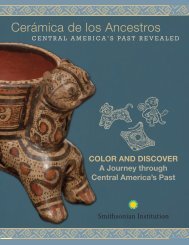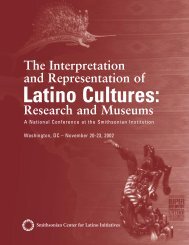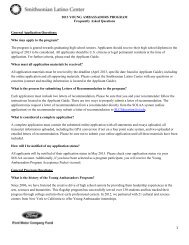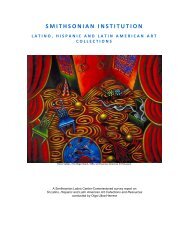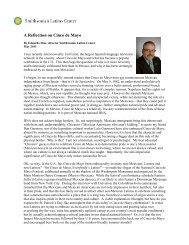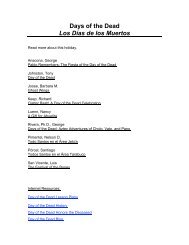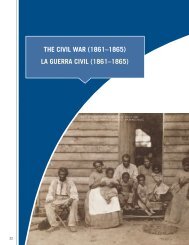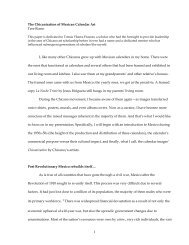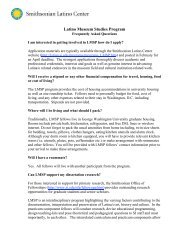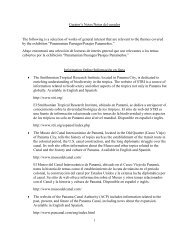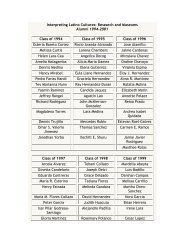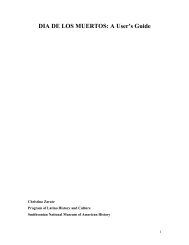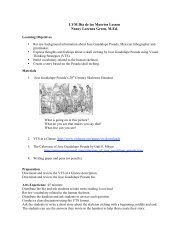Revealing Ancestral Central America - Smithsonian Latino Center ...
Revealing Ancestral Central America - Smithsonian Latino Center ...
Revealing Ancestral Central America - Smithsonian Latino Center ...
You also want an ePaper? Increase the reach of your titles
YUMPU automatically turns print PDFs into web optimized ePapers that Google loves.
Printed in conjunction with the exhibition<br />
Cerámica de los Ancestros: <strong>Central</strong> <strong>America</strong>’s Past Revealed,<br />
on view at the National Museum of the <strong>America</strong>n Indian<br />
in Washington, DC, March 29, 2013–February 1, 2015.<br />
© 2013 <strong>Smithsonian</strong> Institution. All rights reserved.<br />
No part of this book may be reproduced in any manner<br />
whatsoever without written permission of the<br />
<strong>Smithsonian</strong> Institution except in the case of brief<br />
quotations embodied in critical articles and reviews.<br />
The <strong>Smithsonian</strong> <strong>Latino</strong> <strong>Center</strong> ensures that <strong>Latino</strong><br />
contributions to the arts, sciences, and humanities<br />
are highlighted, understood, and advanced through<br />
the development and support of public programs,<br />
research, museum collections, and educational<br />
opportunities at the <strong>Smithsonian</strong> Institution.<br />
For more information about the <strong>Smithsonian</strong> <strong>Latino</strong><br />
<strong>Center</strong>, visit the SLC website at www.latino.si.edu.<br />
The National Museum of the <strong>America</strong>n Indian<br />
(NMAI) is committed to advancing knowledge and<br />
understanding of the Native cultures of the Western<br />
Hemisphere—past, present, and future—through<br />
partnership with Native people and others. The<br />
museum works to support the continuance of culture,<br />
traditional values, and transitions in contemporary<br />
Native life.<br />
For more information about the <strong>Smithsonian</strong>’s<br />
National Museum of the <strong>America</strong>n Indian, visit the<br />
NMAI website at www.<strong>America</strong>nIndian.si.edu.<br />
FIRST EDITION<br />
The name of the “<strong>Smithsonian</strong>,” “<strong>Smithsonian</strong><br />
Institution,” and the sunburst logo are registered<br />
trademarks of the <strong>Smithsonian</strong> Institution.<br />
<strong>Smithsonian</strong> Institution<br />
<strong>Smithsonian</strong> <strong>Latino</strong> <strong>Center</strong> and<br />
National Museum of the AMERICAN Indian<br />
Director, <strong>Smithsonian</strong> <strong>Latino</strong> <strong>Center</strong>: Eduardo Díaz<br />
Director, National Museum of the <strong>America</strong>n Indian:<br />
Kevin Gover (Pawnee)<br />
Associate Director for Scholarship, NMAI:<br />
David Penney<br />
Associate Director for Museum Programs, NMAI:<br />
Tim Johnson (Mohawk)<br />
Associate Director for Museum Assets and<br />
Operations, NMAI: Jane Sledge<br />
Exhibitions and Public Programs Director, SLC:<br />
Ranald Woodaman<br />
Lead Curator: Ann McMullen, NMAI<br />
Guest Curator: Alexander Benítez<br />
General Editor: Rosemary A. Joyce<br />
Copy Editor: Joan Mentzer<br />
Editorial Assistance: Ann McMullen and<br />
the NMAI Publications Office<br />
Design: Studio A<br />
Alexandria, Virginia<br />
Typeset in Serifa and Locator<br />
Printed in the USA by Four Colour Print Group<br />
This publication received federal support from<br />
the <strong>Latino</strong> Initiatives Pool, administered by the<br />
<strong>Smithsonian</strong> <strong>Latino</strong> <strong>Center</strong>, and additional support<br />
from the National Council of the National Museum of<br />
the <strong>America</strong>n Indian.<br />
Cover: Fig. 86. Greater Nicoya female figure on a<br />
feline-effigy bench. See page 61. Photo by Ernest<br />
Amoroso.<br />
Back cover: Fig. 56. Classic period Maya male figure.<br />
See page 41.<br />
Title page: Fig. 10. Greater Coclé animal figure.<br />
See page 16.<br />
Page 10: Fig. 60. Classic period Maya vessel depicting<br />
a nobleman carried on a palanquin (detail).<br />
See page 44.<br />
Page 68: Fig. 112. Greater Coclé (Conté style) footed<br />
plate with crocodile design. See page 75.<br />
4 REVEALING ANCESTRAL CENTRAL AMERICA



